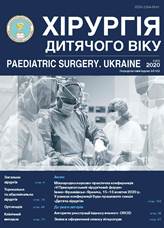Hypermobile spleen in congenital diaphragmatic hernia. Prevention and correction of complications
DOI:
https://doi.org/10.15574/PS.2020.67.22Keywords:
mobile spleen, congenital diaphragmatic hernia, splenopexy, choledochal cystAbstract
Hypermobile or wandering spleen is a rare pathology caused by weakness or an absence of supporting ligaments of the spleen. There are known asymptomatic clinical presentations and presence of the symptoms is associated with a torsion of the pedicle or compression of other organs. In the recent review of all cases of wandering spleen revealed single cases of mobile spleen associated with congenital diaphragmatic hernia (CDH) and some complications without emphasis on their prevention.
Purpose – optimization of medical tactics in children with CDH taking into account the presence of a mobile spleen.
Materials and methods. A retrospective analysis of surgical correction of CDH in 123 children undergoing treatment at the NCSH «OKHMATDYT» during 2009–2019 was conducted. The study included 6 patients who showed signs of a mobile spleen during surgery for left-sided CDH correction, or who had complications associated with this anomaly during the postoperative period. Mobile spleen and its complications were identified by ultrasound, upper esophagogastrial contrast study, intraoperative revision, and gallbladder and choledochal duct contrast study.
Results and discussion. In this study group of patients, 4 (66.7%) patients were diagnosed with a mobile spleen during primary surgery, and 2 (33.3%) were diagnosed on the basis of clinical symptoms that developed after correction of CDH. Complications of the hypermobile spleen in our patients were as follows: obstruction of the stomach and external biliary tract, which were clinically manifested by symptoms such as mechanical icterus, spitting up and vomiting. The lengthening of the gastro-splenic ligament to 4–6 cm, the absence or lengthening of the spleno-diaphragmatic ligament to 4–5 cm, the absence of the splenic-renal ligament were revealed. Splenopexy was performed as a simultaneous operation during correction of diaphragmatic hernia (n=4) or as a second operation (n=2) to eliminate the complications of the vagus spleen. There was no need for repeated surgical interventions in these patients.
Conclusions. CDH is a multicomponent malformation and the mobile spleen is an integral part of it. Increased mobility of the spleen after correction of CDH can be the cause of such complications as torsion and infarction of the spleen, compression and deformation of the stomach with gastroesophageal reflux, compression of the external biliary tract with their extension and simulation of the choledochal cyst, etc. Therefore, verification and correction of the mobile spleen during CDH repair should become a necessary element of surgical tactics.
The research was carried out in accordance with the principles of the Helsinki Declaration. The study protocol was approved by the Local Ethics Committee of these Institutes. The informed consent of the patient was obtained for conducting the studies.
References
Borher JV. (1940). Torsion of a wandering spleen complicated by diaphragmatic hernia. Ann Surg. 111: 416–426. https://doi.org/10.1097/00000658-194003000-00008; PMid:17857547 PMCid:PMC1387896
Cantone N, Gulia C, Miele V et al. (2016). Wandering spleen and organoaxial gastric volvulus after Morgagni hernia repair: a case report and review of the literature. Case Rep Surg. 2016: 6450765. https://doi.org/10.1155/2016/6450765; PMid:27703832 PMCid:PMC5039297
Fiquet–Francois C, Belouadah M, Ludot H et al. (2010). Wandering spleen in children: multicenter retrospective study. J Pediatr Surg. 45: 1519–1524. https://doi.org/10.1016/j.jpedsurg.2010.03.003; PMid:20638536
Francois–Fiquet C, Renard Y, Avisse C, Ludot H, Belouadah M, Polimerol ML. (2011). Laparoscopic gastropexy for the treatment of wandering spleen with or without gastric volvulus. In: Elgeidie A, Editor. Updated topics in minimally invasive abdominal surgery: 205–222. https://doi.org/10.5772/17800; PMid:22153181
Kryvchenia DIu, Prytula VP, Ksonz IV, Faizullakh SKh, Rudenko YeO, Metlenko OV. (2008). Blukaiucha selezinka pry diafrahmalnii hryzhi u ditei. Khirurhiia dytiachoho viku. V; 2(19): 98–102.
Kryvchenia DIu, Dubrovin OH, Metlenko OV, Faizulla SKh. (2003). Refliuks-ezofahit z peptychnym stenozom stravokhodu ta ektopiieiu selezinky pislia korektsii vrodzhenoi diafrahmalnoi hryzhi ta fundoplikatsii za Nissen. Klinichna khirurhiia. 10: 56–57.
Kryvchenia DIu, Dubrovin OH, Sliepov OK, Prytula VP, Rudenko YeO, Metlenko OV, Khusseini SF. (2003). Shlunkovostravokhidnyi refliuks pislia korektsii vrodzhenykh hryzh kupola diafrahmy u ditei. Halytskyi likarskyi visnyk. 10; 4: 39–42.
Mehta A, Vana PG, Glynn L. (2013). Splenic torsion after congenital diaphragmatic hernia repair: case report and review of the literature. Journal of Pediatric Surgery. 48 (3): E29–E31. https://doi.org/10.1016/j.jpedsurg.2013.01.003; PMid:23480945
Parisinos CA, Matter I, Mogilner JG, Rodrigues MA, Slijper N. (2011). Right abdominal mass in a 2 year-old child. BMJ. Case Reports. https://doi.org/10.1136/bcr.08.2011.4676; PMid:22675015 PMCid:PMC3207771
Soleimani M, Mehrabi A, Kashfi A et al. (2007). Surgical treatment of patients with wandering spleen: report of six cases with a review of the literature. Surg Today. 37: 261–269. https://doi.org/10.1007/s00595-006-3389-0; PMid:17342372
Thomas Ng, Marc S. Lessin, Francois I. Luks. (1997). Wandering spleen presenting as duodenal obstruction after repair of СDH. Journal of Pediatric Surgery. 32 (12): 1790–1792. https://doi.org/10.1016/S0022-3468(97)90537-6
Yasuda H, Inoue M, Uchida K et al. (2010). Wandering spleen causing intestinal obstruction after repair of congenital diaphragmatic hernia. Eur J Pediatr Surg. 20: 121–123. https://doi.org/10.1055/s-0029-1220708; PMid:19548195
Downloads
Published
Issue
Section
License
The policy of the Journal “PAEDIATRIC SURGERY. UKRAINE” is compatible with the vast majority of funders' of open access and self-archiving policies. The journal provides immediate open access route being convinced that everyone – not only scientists - can benefit from research results, and publishes articles exclusively under open access distribution, with a Creative Commons Attribution-Noncommercial 4.0 international license(СС BY-NC).
Authors transfer the copyright to the Journal “PAEDIATRIC SURGERY.UKRAINE” when the manuscript is accepted for publication. Authors declare that this manuscript has not been published nor is under simultaneous consideration for publication elsewhere. After publication, the articles become freely available on-line to the public.
Readers have the right to use, distribute, and reproduce articles in any medium, provided the articles and the journal are properly cited.
The use of published materials for commercial purposes is strongly prohibited.

